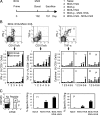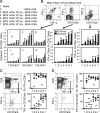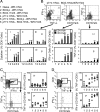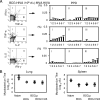Vaccine platform for prevention of tuberculosis and mother-to-child transmission of human immunodeficiency virus type 1 through breastfeeding
- PMID: 17596303
- PMCID: PMC1951420
- DOI: 10.1128/JVI.00707-07
Vaccine platform for prevention of tuberculosis and mother-to-child transmission of human immunodeficiency virus type 1 through breastfeeding
Abstract
Most children in Africa receive their vaccine against tuberculosis at birth. Those infants born to human immunodeficiency virus type 1 (HIV-1)-positive mothers are at high risk of acquiring HIV-1 infection through breastfeeding in the first weeks of their lives. Thus, the development of a vaccine which would protect newborns against both of these major global killers is a logical yet highly scientifically, ethically, and practically challenging aim. Here, a recombinant lysine auxotroph of Mycobacterium bovis bacillus Calmette-Guérin (BCG), a BCG strain that is safer than those currently used and expresses an African HIV-1 clade-derived immunogen, was generated and shown to be stable and to induce durable, high-quality HIV-1-specific CD4(+)- and CD8(+)-T-cell responses. Furthermore, when the recombinant BCG vaccine was used in a priming-boosting regimen with heterologous components, the HIV-1-specific responses provided protection against surrogate virus challenge, and the recombinant BCG vaccine alone protected against aerosol challenge with M. tuberculosis. Thus, inserting an HIV-1-derived immunogen into the scheduled BCG vaccine delivered at or soon after birth may prime HIV-1-specific responses, which can be boosted by natural exposure to HIV-1 in the breast milk and/or by a heterologous vaccine such as recombinant modified vaccinia virus Ankara delivering the same immunogen, and decrease mother-to-child transmission of HIV-1 during breastfeeding.
Figures






Similar articles
-
Novel recombinant Mycobacterium bovis BCG, ovine atadenovirus, and modified vaccinia virus Ankara vaccines combine to induce robust human immunodeficiency virus-specific CD4 and CD8 T-cell responses in rhesus macaques.J Virol. 2010 Jun;84(12):5898-908. doi: 10.1128/JVI.02607-09. Epub 2010 Apr 7. J Virol. 2010. PMID: 20375158 Free PMC article.
-
Dual neonate vaccine platform against HIV-1 and M. tuberculosis.PLoS One. 2011;6(5):e20067. doi: 10.1371/journal.pone.0020067. Epub 2011 May 13. PLoS One. 2011. PMID: 21603645 Free PMC article.
-
Priming with a recombinant pantothenate auxotroph of Mycobacterium bovis BCG and boosting with MVA elicits HIV-1 Gag specific CD8+ T cells.PLoS One. 2012;7(3):e32769. doi: 10.1371/journal.pone.0032769. Epub 2012 Mar 29. PLoS One. 2012. PMID: 22479338 Free PMC article.
-
Recombinant live vaccine candidates against tuberculosis.Curr Opin Biotechnol. 2012 Dec;23(6):900-7. doi: 10.1016/j.copbio.2012.03.007. Epub 2012 Apr 4. Curr Opin Biotechnol. 2012. PMID: 22483201 Review.
-
Recombinant BCG vaccine candidates.Curr Mol Med. 2007 Jun;7(4):365-72. doi: 10.2174/156652407780831610. Curr Mol Med. 2007. PMID: 17584076 Review.
Cited by
-
Robust immunity to an auxotrophic Mycobacterium bovis BCG-VLP prime-boost HIV vaccine candidate in a nonhuman primate model.J Virol. 2013 May;87(9):5151-60. doi: 10.1128/JVI.03178-12. Epub 2013 Feb 28. J Virol. 2013. PMID: 23449790 Free PMC article.
-
Molecular characterization of heterologous HIV-1gp120 gene expression disruption in mycobacterium bovis BCG host strain: a critical issue for engineering mycobacterial based-vaccine vectors.J Biomed Biotechnol. 2010;2010:357370. doi: 10.1155/2010/357370. Epub 2010 Jun 27. J Biomed Biotechnol. 2010. PMID: 20617151 Free PMC article.
-
Protective T cell immunity against respiratory syncytial virus is efficiently induced by recombinant BCG.Proc Natl Acad Sci U S A. 2008 Dec 30;105(52):20822-7. doi: 10.1073/pnas.0806244105. Epub 2008 Dec 15. Proc Natl Acad Sci U S A. 2008. PMID: 19075247 Free PMC article.
-
All Eyes on the Prefusion-Stabilized F Construct, but Are We Missing the Potential of Alternative Targets for Respiratory Syncytial Virus Vaccine Design?Vaccines (Basel). 2024 Jan 18;12(1):97. doi: 10.3390/vaccines12010097. Vaccines (Basel). 2024. PMID: 38250910 Free PMC article. Review.
-
Priming with recombinant auxotrophic BCG expressing HIV-1 Gag, RT and Gp120 and boosting with recombinant MVA induces a robust T cell response in mice.PLoS One. 2013 Aug 20;8(8):e71601. doi: 10.1371/journal.pone.0071601. eCollection 2013. PLoS One. 2013. PMID: 23977084 Free PMC article.
References
-
- Adkins, B., C. Leclerc, and S. Marshall-Clarke. 2004. Neonatal adaptive immunity comes of age. Nat. Rev. Immunol. 4:553-564. - PubMed
-
- Alter, G., J. M. Malenfant, and M. Altfeld. 2004. CD107a as a functional marker for the identification of natural killer cell activity. J. Immunol. Methods 294:15-22. - PubMed
-
- Ami, Y., Y. Izumi, K. Matsuo, K. Someya, M. Kanekiyo, S. Horibata, N. Yoshino, K. Sakai, K. Shinohara, S. Matsumoto, T. Yamada, S. Yamazaki, N. Yamamoto, and M. Honda. 2005. Priming-boosting vaccination with recombinant Mycobacterium bovis bacillus Calmette-Guerin and a nonreplicating vaccinia virus recombinant leads to long-lasting and effective immunity. J. Virol. 79:12871-12879. - PMC - PubMed
-
- Andersson, G. E., and P. M. Sharp. 1996. Codon usage in the Mycobacterium tuberculosis complex. Microbiology 142:915-925. - PubMed
Publication types
MeSH terms
Substances
Grants and funding
LinkOut - more resources
Full Text Sources
Other Literature Sources
Medical
Research Materials

